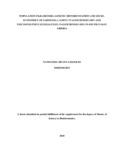| dc.description.abstract | Fish is a source of protein to over 20 million people. This contribute to food security and poverty alleviation in coastal communities of the world leading to overexploitation in most fisheries in Africa. This study investigated growth, mortality parameters and exploitation rate of Sardinella aurita and Pseudotolithus senegalensis. The analysis were based on 2,270 specimens of S. aurita and 1,711 specimens of P. senegalensis collected between December 2016 and May 2017 nearshore waters off Liberia. Genetic differentiation and socio-economic status of the two fish species were also determined.
The growth parameters and performance index estimated based on von Bertalanffy model gave the asymptotic length L∞ of S. aurita which ranged between 34.50 to 36.00 cm, growth coefficient K at 0.50 to 1.18 year-1, theoretical age at length zero t₀ between 0.502 and 0.895 year-1 and performance index Ø' from 2.77 to 3.18 year-1. Pesudotolithus senegalensis asymptotic length varied between L∞ 52.99 to 60.00 cm, K 0.50 to 1.03, t₀ 0.551 to 0.88 and Ø' 3.13 to3.52 year-1 at Montserrado (Gbanjor, West Point and King Gray & ELWA) and Marshall respectively. The slope b of the length-weight relationship were 1.89 to 1.97 and 2.3 to 2.8 in Montserrado and Marshall. Estimates of total, natural and fishing mortality for S. aurita and P. senegalensis were found between 6.36 to 9.61 and 1.50 to 6.11 year-1; 1.38 to 1.87 and 0.9 to 1.51 year-1 and 4.98 to 7.74 and 0.54 to 4.60 year-1 at Montserrado and Marshall. The high value of exploitation (0.75 to 0.81) ratio of S aurita and P. senegalensis at Gbanjor, West Point, King Gray & ELWA and Marshall indicated that these species were harvested at a higher level than the optimum fishing mortality but (0.36) for P. senegalensis at King Gray & ELWA was lower than the optimum fishing mortality. Analysis of yield per recruit suggested that S. aurita and P. senegalensis stocks in the two fisheries needs regulatory measures for sustainable management.
Sardinella aurita and Pseudotolithus senegalensis revealed inter-species variations of genetic diversity using four molecular markers from 12 taxa obtained from National Center for Biotechnology Information. Phylogeny reconstruction using the selected markers (16s, COI, Cytb and Rag-1) revealed distance relationship between S. aurita and P. senegalensis. The fascinating result from this analysis is the well supported monophyly for S. aurita and H. jaguana in trees using 16s, COI, and Rag-1 genes.
An average rate of 36 – 52 fishermen accounted for 48 – 68 % of the daily catch. Gill nets contribute (80%) of the fisheries. The highest catches recorded for S. aurita and P. senegalensis were in January and February at Montserrado and Marshall while the lowest catches were in April and May.
The stocks of S. aurita and P. senegalensis nearshore off Montserrado and Marshall were found to be over-exploited. This study provides relevant information to monitor stocks over time in areas sensitive to fishing pressure, size-limit regulation of fishing gear mesh size and time-limit regulation of restricting fishing during spawning seasons in nursery areas for sustainability. | en_US |

